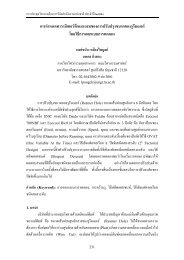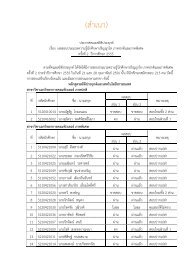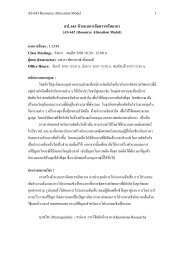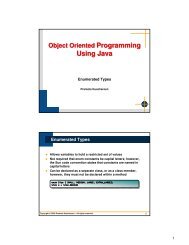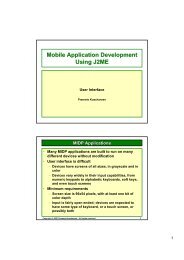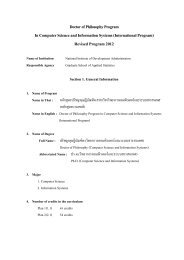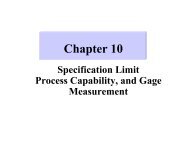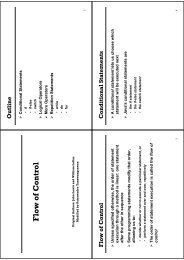ดาวน์โหลด All Proceeding - AS Nida
ดาวน์โหลด All Proceeding - AS Nida
ดาวน์โหลด All Proceeding - AS Nida
Create successful ePaper yourself
Turn your PDF publications into a flip-book with our unique Google optimized e-Paper software.
51<br />
การประชุมวิชาการดานการวิจัยดําเนินงานแหงชาติ ประจําป 2554<br />
วันที่<br />
8-9 กันยายน 2554 ณ โรงแรม เอส ดี อเวนิว กรุงเทพฯ<br />
Flexible Printed Circuit Process Improvement via<br />
Interchangeable Linear Constrained Response Surface Optimisation Models<br />
Pichpimon Kanchanasuttisang 1 and Pongchanun Luangpaiboon 2<br />
1, 2<br />
Industrial Statistics and Operational Research Unit (ISO-RU),<br />
Department of Industrial Engineering, Faculty of Engineering, Thammasat University, Pathumthani, Thailand<br />
Tel: 025643002-9 Ext 3081 Fax: 025643017 E-mail: 1 pichpimon@hotmail.com, 2 lpongch@engr.tu.ac.th<br />
Abstract<br />
This paper presents a collection of experimental design and<br />
mathematical programming techniques for quality improvement in<br />
automotive electronic parts. The quality performance of interest is<br />
measured via the relationship of the etched rate of acid solution and<br />
circuit width, one of the key failure and break down to LED of lighting<br />
vehicles. With lower levels from monitoring the product quality the<br />
manufacturer has spent a lot of cost and time for product verification<br />
procedures. This brings the production with higher levels of waste and<br />
lead time. To validate on processing and to sustain finished goods with<br />
the permanent prevention, the precisely etched condition should be<br />
optimised. The proper factorial experiments, multiple regression and<br />
mathematical programming approaches are applied to investigate the<br />
preferable levels of significant process variables in order to improve the<br />
quality of etched rate. The interchangeable constrained response surface<br />
optimisation models provide the new operating conditions. The<br />
experimental results in each part with less than twenty five lines showed<br />
that the first model decreases the bottom circuit width deviation from<br />
0.0026 to 0.0024 and the latter model decreases the etching rate from<br />
2.033 to 1.124.<br />
Keywords: Flexible Printed Circuit Process, Circuit Width, Etched<br />
Rate, Response Surface Methodology, Multiple Regression,<br />
Steepest Descent<br />
1. INTRODUCTION<br />
In the field of an electronic circuitry, the flexible printed<br />
circuits (FPC) have been developed for lighting automotive vehicles by<br />
assembling with the LED. The emission light and optical properties are<br />
mainly relied on the width of an FPC circuit line. An existing process to<br />
confirm the correct width of a lead line in an electronic field is a<br />
damaged part investigation. The process obviously causes the high<br />
quality cost in FPC manufacturers.<br />
Currently, the circuit width of the FPC is with lower process<br />
capability (Cpk) at -3.03 on the top circuit width and 0.85 on the bottom<br />
circuit width that comparing to the minimal target at 1.33 as shown in<br />
Fig. 1. In this case, the deep details of an etching process should be<br />
investigated so that the optimal working condition would be determined<br />
as a standard process.<br />
LS L<br />
Process Data<br />
0.09<br />
Target 0.1<br />
USL 0.11<br />
Sample M ean 0.0740333<br />
Sample N 60<br />
StD ev (Within) 0.00175612<br />
StD ev (O v erall) 0.00173661<br />
O bserv ed P erform ance<br />
P P M < LSL 1000000.00<br />
PPM > USL 0.00<br />
P P M Total 1000000.00<br />
LS L<br />
P rocess D ata<br />
0.09<br />
Target 0.1<br />
USL 0.11<br />
Sample M ean 0.09655<br />
Sample N 60<br />
StD ev (Within) 0.00257149<br />
StD ev (O v erall) 0.00256062<br />
O bserv ed P erform ance<br />
PPM < LSL 0.00<br />
PPM > USL 0.00<br />
PPM Total 0.00<br />
Process Capability of Top circuit width<br />
LSL Target USL<br />
0.072 0.078 0.084 0.090 0.096 0.102<br />
Exp. Within Performance<br />
P P M < LSL 1000000.00<br />
PPM > USL 0.00<br />
P P M Total 1000000.00<br />
Exp. O verall Performance<br />
P P M < LSL 1000000.00<br />
PPM > USL 0.00<br />
P P M Total 1000000.00<br />
0.108<br />
Process Capability of Bottom circuit width<br />
LSL Target USL<br />
0.0900 0.0936 0.0972 0.1008 0.1044<br />
Exp. Within Performance<br />
PPM < LSL 5430.21<br />
PPM > USL 0.08<br />
PPM Total 5430.30<br />
E xp. O v erall P erform ance<br />
PPM < LSL 5264.21<br />
PPM > USL 0.07<br />
PPM Total 5264.28<br />
0.1080<br />
Within<br />
Overall<br />
P otential (Within) C apability<br />
C p 1.90<br />
C P L -3.03<br />
CPU 6.83<br />
C pk -3.03<br />
O v erall C apability<br />
P p 1.92<br />
PPL -3.06<br />
P P U 6.90<br />
P pk -3.06<br />
Cpm 0.13<br />
Within<br />
Overall<br />
P otential (Within) C apability<br />
C p 1.30<br />
CPL 0.85<br />
CPU 1.74<br />
Cpk 0.85<br />
O v erall C apability<br />
Pp 1.30<br />
PPL 0.85<br />
PPU 1.75<br />
Ppk 0.85<br />
Cpm 0.77<br />
Fig.1 Current Performance on Top and Bottom Circuit Widths.




